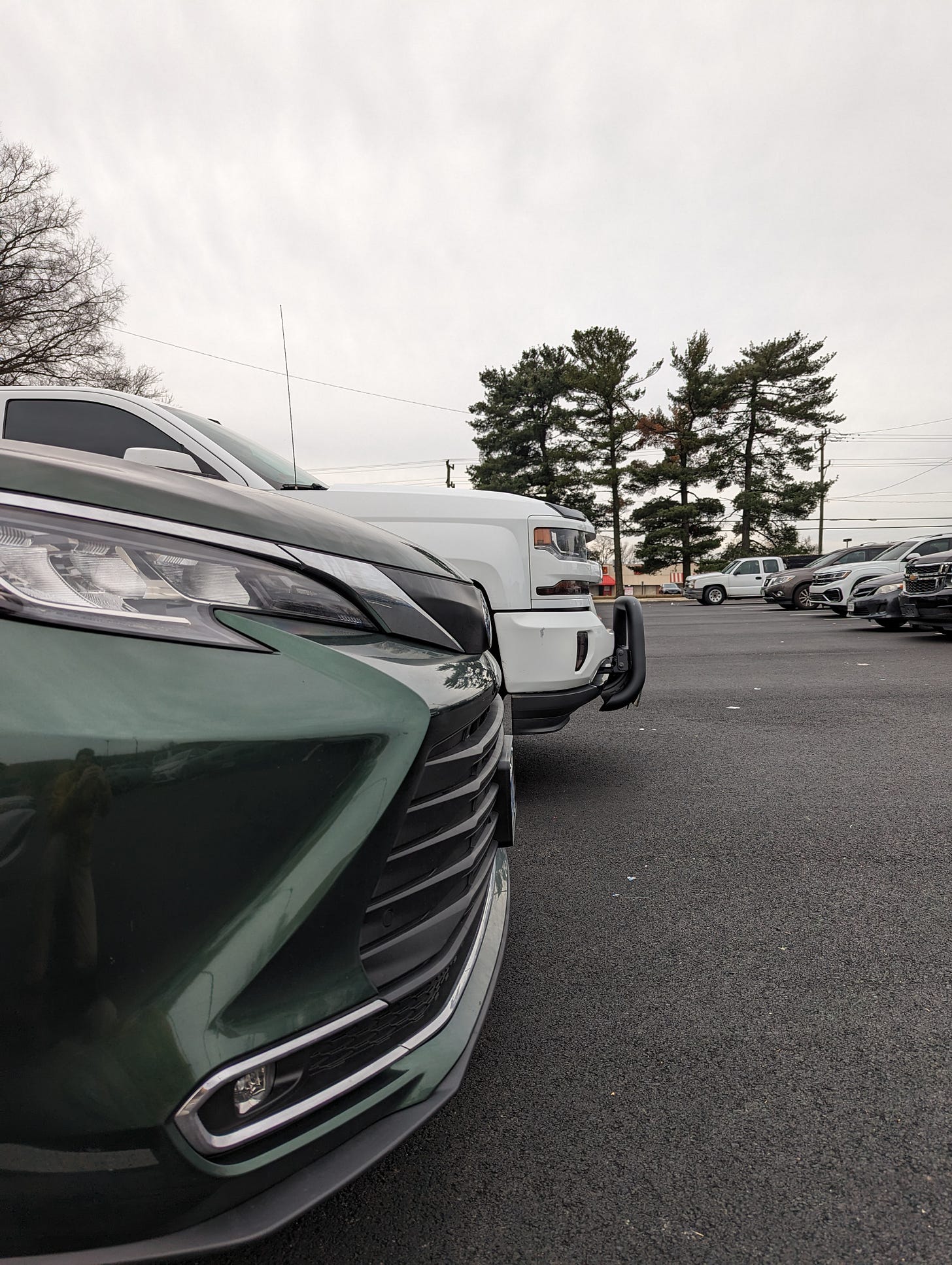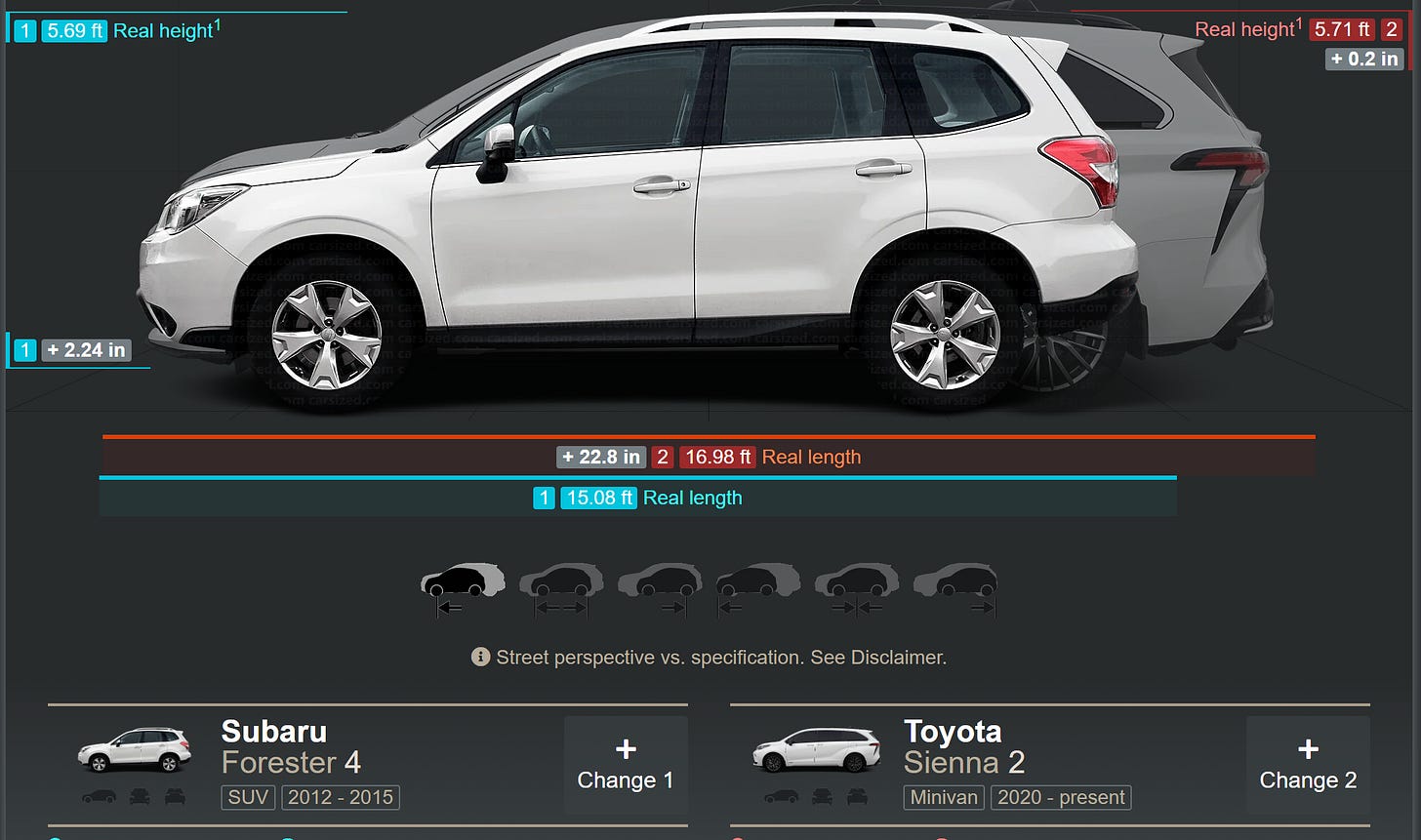Minivan As Grand Safety Compromise
Plus: I will be appearing in USA Today and at YIMBYtown!
Next week USA Today should be publishing an op-ed I wrote via Young Voices about why the housing shortage is a literal shortage. And I will be at YIMBYtown early next week in Austin, speaking on a panel about housing advocacy and organizing in the suburbs. Please email lucagattonicelli@substack.com if you are attending. I am excited to meet so many folks in person! Since next week I will be busy …
I have wanted to write about why exactly minivans are great, from sliding doors to the cargo well behind the rear axle, for at least a year. I joke they are like sharks, incredibly well-evolved for their niche. But I had a more interesting realization about design features that make them admirably safe for all parties, which led me to reflections on zero-sum thinking about automotive safety.
Minivans offer a great compromise of safety for occupants of the van, occupants of other cars, and pedestrians and cyclists. The front is low enough to be safer for pedestrians than a pickup truck, truck-based SUV, or even some traditional car-based crossover SUVs [EDIT: IIHS reached this conclusion in a formal study]. It is high enough to protect van occupants in a collision with a tall vehicle. A minivan’s beltline — the side windows’ bottom edge — is also high enough to protect the precious cargo inside. And the rear is obviously tall and well-reinforced.
The green 2023 Toyota Sienna minivan pictured above is ours. Right off the bat you can see how much taller the hood of the adjacent Chevy Silverado is. The pickup might have had a modest suspension lift or slightly bigger wheels than stock, but that would not make much of a difference. A pedestrian hit by the Sienna would be much more likely to bounce onto the hood, not under the vehicle to be crushed.
Driving a big truck probably reduces the safety of people around you far more than it increases your own safety. But some people need to drive a truck.
Our van’s external visibility is not great, much worse than the Subaru Forester it replaced, but still better than the “forward blind spot” (yikes!) of big car and truck-based SUVs. Even as a large vehicle in its own right, our Sienna is dwarfed by a Ford F-150, the best-selling vehicle in America. I am a little shorter than the Sienna (and loving it, convenient for buckling kids in); the F-150 is almost as tall as Michael Jordan.
Check out the site to compare cars for yourself. My un-scientific analysis is that the Sienna looks close enough in size to the F-150 to stand a chance in a collision. The van weighs about 4,600 pounds to the roughly 6,500-pound truck. Not a fair fight by boxing standards, but reasonably close. Our old Forester weighed maybe 3,500 pounds, almost half as much as the F-150! Now compare the Sienna and Forester:
Pretty close up front, setting aside the vehicles’ weight difference. The Sienna admittedly poses substantially more risk to pedestrians than a Honda Civic, however:
Which brings us to the troubling arms race of vehicle size in recent years. The smallest car I can comfortably imagine my kids driving around in is something like a Toyota Corolla Cross, a subcompact crossover SUV. Here is a final comparison:
An F-150 driver could almost see over a Corolla Cross’s roof. But I would still feel fine watching my kids drive off in one, I think. Minivans’ weight and size — they stopped being mini long ago — is honestly the biggest reason I see them as a viable safety compromise. These days a car must be expected to protect its occupants from trucks that weigh as much as a female Asian elephant.
To be clear, I am not especially critical of truck owners. I do think choosing a pickup as your daily driver, especially if you rarely have more than one passenger, is ethically questionable for safety and environmental reasons, assuming you do not regularly haul loads, tow, or tackle rough terrain. A point I somehow left out of my previous meditation on car culture is that if you need a truck, you should drive one. I actually have huge respect for people who need a truck. Many of them have jobs that keeps society going, like farming, maintaining the roads or, indeed, building homes.
Many pixels have been illuminated by the discourse around the safety rationale for driving large vehicles, especially light trucks (the official term) and truck-based SUVs. The local lead in Falls Church City for my YIMBY group spawned at least two chains of parodies with his rather funny response to a viral post on Twitter:
My discourse contribution is that pickup trucks are not inherently safe vehicles. The generation of F-150 I grew up with folds like an accordion in crash testing. It weighed between ~4,000 and ~5,000 pounds, still pretty hefty by today’s standards. So weight does not equate to safety. Cars have gotten significantly safer in the past two decades principally because of how they are designed and engineered, not because they are heavier and more likely to crush another vehicle. Driving a big truck probably reduces the safety of people around you far more than it increases your own safety.
Today’s F-150s and Ram 1500s have good crash test ratings, though IIHS testing identified two safety weaknesses in the Chevy Silverado we started with.
Minivans are not perfect either. “Minivans don’t make the grade when it comes to rear-seat safety,” IIHS reported in September 2023. Older children sitting in the second row with a regular seatbelt — no booster or safety seat — do not fare very well based on the group’s new moderate overlap test. It, of course, felt weird as a parent to learn that our car is significantly flawed in its defining purpose: transporting children.
The big lesson here might be that even in the realm of automotive safety, where we can conceivably always add more crash structure, more technology, more everything, limitations and trade-offs are unavoidable. Hopefully automotive safety will matter much less in the future because people have better alternatives.
I decided not to delve into the stigma around minivans, but want to note that car enthusiasts including myself are enthusiastic about them too, because they do their job extremely well, better than any SUV could. Car nuts also enjoy being contrarian.
I wish to close by thanking my 178 subscribers, especially my three paid subs. 2024 really is the year I will be writing more consistently. This blog is my best shot at figuring out a career in urbanism and housing, so I deeply appreciate your readership.
If you enjoy this blog or want to work together, please contact lucagattonicelli@substack.com. I would love to write about a topic suggested by a reader. Visit YIMBYs of Northern Virginia, the all-volunteer grassroots pro-housing organization I founded, at yimbysofnova.org.









